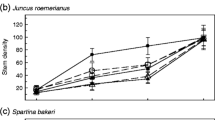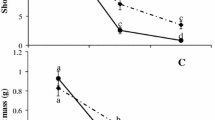Abstract
Factors affecting growth of softstem bulrush (Scirpus validus), an obligate wetland plant frequently used in subsurface-flow constructed wetlands in North America, were studied in a controlled environmental chamber. Effects of media depth (30-and 46-cm), hydraulic retention time (HRT) (2- and 6-day), and water-level drawdown (drawdown vs. no drawdown) on plant growth in 24 microcosms were investigated. Weekly root and stem growth was measured and stem health assessed to determine effects of treatments on plant vigor. Water-level drawdown was detrimental to plant growth, increasing the percentage of dead stems. Stem production was higher in microcosms with a 46-cm media depth than those with a 30-cm depth and also higher in microcosms that were permanently flooded than in those with fluctuating water levels. Root production was greater in microcosms with a 30-cm media depth than in those with a 46-cm depth, and root production was also greater in microcosms that were constantly flooded than in those drawn down. Scirpus validus is a robust plant that grows well in gravel media microcosms; however, problems are experienced when rhizomes and roots dry out during water drainage.
Similar content being viewed by others
Literature Cited
Anderson, V. L. and R. A. McLean. 1974. Design of Experiments. A Realistic Approach. Marcel Dekker, Inc. New York, NY, USA.
Behrends, L. L., H. S. Coonrod, E. Bailey, and M. J. Bulls. 1993. Oxygen diffusion rates in static and reciprocating rock filters. Proceedings of Subsurface Flow Constucted Wetlands Conference. Center for Environmental Resource Management, University of Texas, El Paso, TX, USA.
Breen, P. F. 1990. A mass balance method for assessing the potential of artificial wetlands for wastewater treatment. Water Research 24: 689–697.
Brix, H. 1994. Functions of macrophytes in constructed wetlands. Water Science and Technology 29:71–78.
Brown, D. S. and S. C. Reed. 1994. Inventory of constructed wetlands in the United States. Water Science and Technology 29:309–318.
Burgoon, P. S., K. R. Reddy, and T. A. DeBusk. 1995. Performance of subsurface flow wetlands with batch-load and continuous-flow conditions. Water Environment Research 67:855–862.
Butler, J. E., M. G. Ford, E. May, R. F. Ashworth, J. B. Williams, A. Dewedar, M. El-Housseini, and M. M. M. Baghat. 1993. Gravel bed hydroponic sewage treatment: Performance and potential. p. 237–248. In G. A. Moshiri (ed.) Constructed Wetlands for Water Quality Improvement. CRC Press, Inc., Boca Raton, FL, USA.
Cole, S. 1998. The emergence of treatment wetlands. Environmental Science and Technology 32:218A-223A.
Cooper, P. F. 1993. The use of reed bed systems to treat domestic sewage: the european design and operations guidelines for reed bed treatment systems. p. 203–217. In G. A. Moshiri (ed.) Constructed Wetlands for Water Quality Improvement. CRC Press, Inc., Boca Raton, FL, USA.
Edwards, M. E. 1990. A study of soft-stem bulrush (Scirpus validus) growth in a constructed wetland, Hardin, Kentucky. Tennessee Valley Authority, Chattanooga, TN, USA. Addendum to Contract No. TV-81976V.
Edwards, M. E., K. C. Brinkman, and J. T. Watson. 1993. Growth of soft-stem bulrush (Scirpus validus) plants in a gravel-based subsurface flow constructed wetland. p. 415–425. In G. A. Moshiri (ed.) Constructed Wetlands for Water Quality Improvement. CRC Press, Inc., Boca Raton, FL, USA.
Freeman, Jr., R. J. 1993. Constructed wetlands experience in the Southeast. p. 69–74. In G. A. Moshiri (ed.) Constructed Wetlands for Water Quality Improvement. CRC Press, Inc., Boca Raton, FL, USA.
Gersberg, R. M., S. R. Lyon, R. Brenner, and B. V. Elkins. 1989. Integrated wastewater treatment using artificial wetlands: A gravel marsh case study. p. 142–152. In D.A. Hammer (ed.) Constructed Wetlands for Wastewater Treatment. Lewis Publishers, Chelsea, MI, USA.
Hurry, R. J. and E. G. Bellinger. 1990. Potential yield and nutrient nemoval by harvesting of Phalaris arundinacea in a wetland treatment system. p. 543–546. In P. F. Cooper and B. C. Findlater (ed.) Constructed Wetlands in Water Pollution Control. Pergamon Press, Oxford, UK.
Kadlec, R. H. and K. L. Knight. 1996. Treatment Wetlands. CRC Press, Inc. Boca Raton, FL, USA.
Kemp, M. 1995. Assessment and enhancement of nitrogen transformation and removal in a subsurface flow constructed wetlands system treating municipal wastewater. Ph.D. Dissertation. Tennessee Technological University, Cookeville, TN, USA
Knight, R. L. 1991. Analysis of survival and condition of planted vegetation at the Benton, Hardin, and Pembroke, Kentucky constructed wetland treatment systems. TVA River Basin Operations-Water Resources, Chattanooga TN, USA. Project ATL32879, AO.
Knight, R. L., R. W. Ruble, R. H. Kadlec, and S. Reed. 1993. Wetlands for wastewater treatment: Performance database. p. 35–38. In G.A. Moshiri (ed.) Constructed Wetlands for Water Quality Improvement. CRC Press, Inc., Boca Raton, FL, USA.
May, E., J. E. Butler, M. G. Ford, R. Ashworth, J. Williams, and M. M. M. Baghat. 1990. Chemical and microbiological processes in gravel-bed hydroponic (GBH) systems for sewage treatment. p. 33–40. In P. F. Cooper and B. C. Findlater (eds.) Constructed Wetlands in Water Pollution Control. Pergamon Press, Oxford, UK.
Munsell Color Chart for Plant Tissues. 1977. Munsell Color Macbeth Division of Kollmorgen Instruments Corporation. Baltimore, MD, USA.
Nichols, D. S. 1983. Capacity of natural wetlands to remove nutrients from wastewater. Journal Water Pollution Control Federation. 55:495–505.
Parr, T. W. 1990. Factors affecting reed (Phragmites australis) growth in UK reed bed treatment system. p. 67–76. In P. F. Cooper and B. C. Findlater (eds.) Constructed Wetlands in Water Pollution Control. Pergamon Press, Oxford, UK.
Payne, N. F. 1992. Techniques for Wildlife Management of Wetlands. McGraw-Hill, Inc., New York, NY, USA.
Pullin, B. P. and D.A. Hammer. 1989. Comparison of plant density and growth forms related to removal effeciencies in constructed wetlands treating municipal wastewater. Tennessee Valley Authority, Valley Resource Center, Waste Technology Program, Knoxville, TN, USA.
Pullin, B. P. and D. A. Hammer. 1991. Aquatic plants improve wastewater treatment. Water Environment and Technology 31:36–40.
Reed, S. C. and D. S. Brown. 1992. Constructed wetland design— the first generation. Water Environment Research 64:776–781.
Rogers, K. H., P. F. Breen, and A. J. Chick. 1990. Hydraulics, root distribution, and phosphorous removal in experimental wetland systems. p. 587–590. In P. F. Cooper and B. C. Findlater (eds.) Constructed Wetlands in Water Pollution Control. Pergamon Press, Oxford, UK.
SAS Institute, Inc. 1985. SASR user’s guide: Statistics. Version 5 edition. SAS Institute, Inc., Cary, NC, USA.
Steiner, G. R. and R. J. Freeman, Jr. 1989. Configuration and substrate design considerations for constructed wetlands in wastewater treatment. p. 363–377. In D. A. Hammer (ed.) Constructed Wetlands for Wastewater Treatment. Lewis Publishers. Chelsea, MI, USA.
Surrency, D. 1993. Evaluation of aquatic plants for constructed wetlands. p. 349–357. In G.A. Moshiri (ed.) Constructed Wetlands for Water Quality Improvement. CRC Press, Inc., Boca Raton, FL, USA.
Watson, J. T. 1990. Design and performance of the constructed wetland wastewater treatment system at Phillips High School, Bear Creek, Alabama. Tennessee Valley Authority, Chattanooga, TN, USA. TVA/WR/WQ-90/S.
Watson, J. T., S. C. Reed, R. H. Kadlec, R. L. Knight, and A. E. Whitehouse. 1989. Performance expectations and loading rates for constructed wetlands. p. 319–351. In D.A. Hammer (ed.) Constructed Wetlands for Wastewater Treatment. Lewis Publishers. Chelsea, MI, USA.
Author information
Authors and Affiliations
Corresponding author
Rights and permissions
About this article
Cite this article
Hunter, R.G., Combs, D.L. & George, D.B. Growth of softstem bulrush (Scirpus validus) in microcosms with different hydrologic regimes and media depths. Wetlands 20, 15–22 (2000). https://doi.org/10.1672/0277-5212(2000)020[0015:GOSBSV]2.0.CO;2
Received:
Revised:
Accepted:
Issue Date:
DOI: https://doi.org/10.1672/0277-5212(2000)020[0015:GOSBSV]2.0.CO;2




